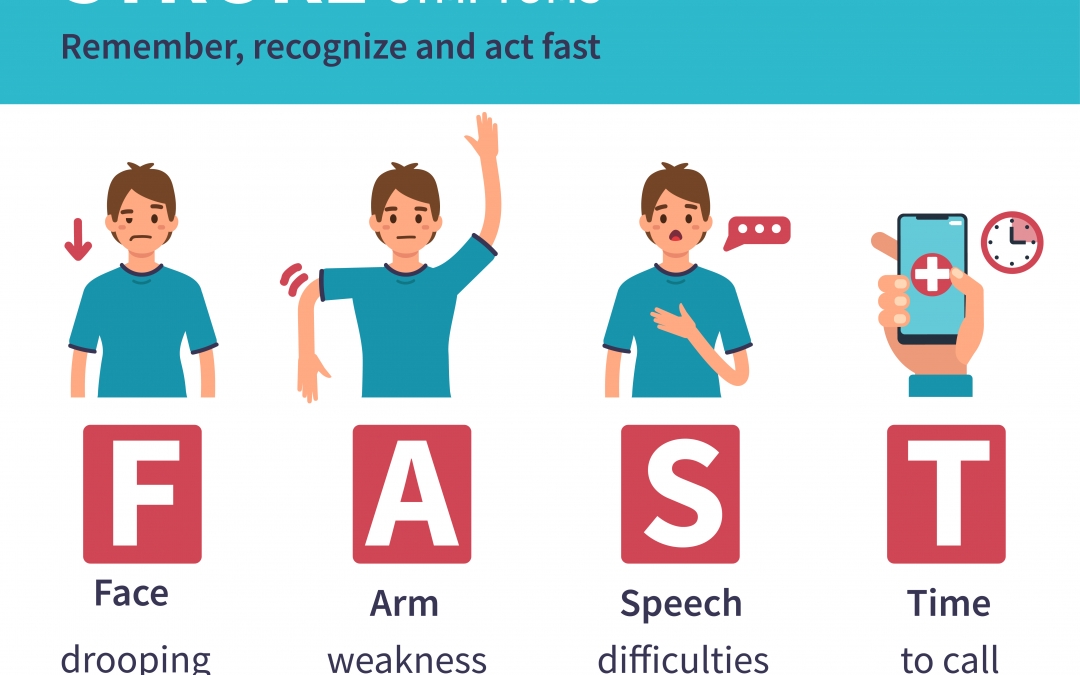4 FAST Signs of a Stroke | Symptoms, Rehabilitation & Treatment
May is National Stroke Awareness Month. The best way to prevent a stroke is to understand exactly what a stroke is and how to identify if someone is showing signs of a stroke. A stroke is a type of brain injury that occurs due to an interruption of the brain’s blood supply. A stroke is the number five cause of death and a leading cause of disability in the United States. The effects from a stroke often require forms of stroke rehabilitation such as stroke physical therapy treatments. The American Stroke Association states that 80 percent of strokes are preventable. Preventing a stroke is possible, if you recognize the symptoms as soon as they occur. According to the Centers for Disease Control, only 3 out of 5 people in the United States are aware of all major stroke symptoms. In order to remember the major stroke symptoms, the acronym FAST is used.
F–FACE—one side of the face is drooping
A–ARMS—weakness in the arms or legs
S–SPEECH—slurred or difficult speech
T–TIME—time is of the essence, call 9-1-1!
Understanding Signs of Stroke
To better understand FAST, you can do a quick check of the person experiencing symptoms.
- Face—does one side of their face droop, or is it numb? Ask the person to smile and note if their smile is uneven.
- Arm weakness—is one arm weak or numb? Ask the person to raise both arms and note if one arm drifts downward.
- Speech—is speech slurred? Is the person unable to speak or are they hard to understand? Ask them to repeat a simple sentence.
- Time—if the person demonstrates any of these symptoms, call 9-1-1 and get them to the hospital, even if the symptoms go away.
Preventing Long Term Effects and Avoiding Stroke Rehabilitation
In addition to FAST, there are other symptoms of stroke that you should be familiar with. These include:
- Sudden numbness or weakness of the face, arm, or leg, especially on one side of the body
- Sudden confusion, trouble speaking or understanding speech
- Sudden difficulty with vision in one or both eyes
- Sudden difficulty walking, dizziness, or loss of balance or coordination
- Sudden severe headache with no known cause
It is important to note the time when any of these symptoms first appear. There are some medical options that may reduce the long-term effects of stroke if they are administered within a designated time frame.
The best thing you can do if you notice any of these symptoms yourself or in someone else, is to act FAST! Knowing the warning signs of a stroke can make the difference between recovery and disability. If you or someone you know experiences one or more of these symptoms, call 9-1-1 immediately!
Stroke Rehabilitation and Stroke Therapy Treatments
In some cases, it may be necessary to seek professional treatment after undergoing a stroke. For most stroke patients, rehabilitation includes occupational, physical and speech therapy.
Stroke Physical Therapy that aims to have the patient relearn simple motor activities such as walking, sitting, standing, lying down, and the process of switching from one movement to another. A physical therapy program may include exercises to strengthen muscles, improve coordination, and regain range of motion; and constraint-induced therapy, in which an unaffected limb is immobilized, causing the person to use the affected limb to regain movement and function.
Stroke Occupational Therapy is also used to treat the effects of a stroke. The goal of occupational therapy is to help stroke patients relearn daily activities including eating, drinking and swallowing, bathing, dressing, cooking, reading and writing, and more. Exercises performed as part of a rehabilitation program using occupational therapy help the patient to regain independence including finger and fine control of objects. This also includes visual and cognitive rehabilitation.
Stroke Speech Therapy may also be necessary as part of a rehabilitation program. Speech therapy can be beneficial to patients who have lost the ability to understand both the written or spoken language or who struggle with communication post-stroke. Speech therapy also improves thinking and memory skills.
Benefits of Post-Stroke Rehabilitation Therapy
Niagara Therapy LLC offers PT, OT, and Speech Therapy for adults focused on the personal goals of each patient and their needs. Our skilled therapists are trained to work with patients specifically seeking stroke rehabilitation treatments to improve muscle function and restore movement.



